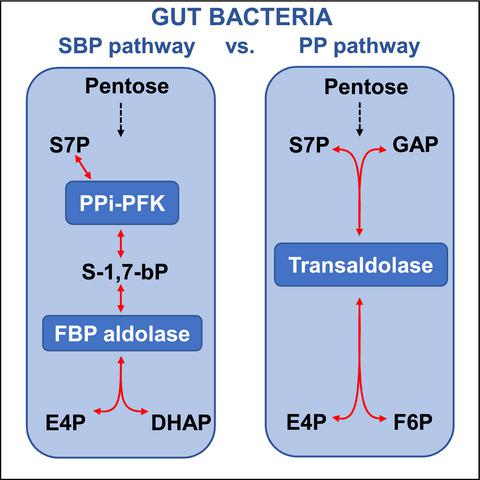Our official English website, www.x-mol.net, welcomes your
feedback! (Note: you will need to create a separate account there.)
An alternative pentose phosphate pathway in human gut bacteria for the degradation of C5 sugars in dietary fibers
The FEBS Journal ( IF 5.5 ) Pub Date : 2020-08-08 , DOI: 10.1111/febs.15511 Laura S Garschagen 1 , Thomas Franke 1 , Uwe Deppenmeier 1
The FEBS Journal ( IF 5.5 ) Pub Date : 2020-08-08 , DOI: 10.1111/febs.15511 Laura S Garschagen 1 , Thomas Franke 1 , Uwe Deppenmeier 1
Affiliation

|
The microbial degradation of pentoses in the human gut is a crucial factor for the utilization of plant‐based dietary fibers. A vast majority of gut microbes are able to use these C5‐sugars as a carbon and energy source. However, the underlying metabolic pathways are not fully understood. Bioinformatic analysis showed that a large number of abundant gut bacteria lack genes encoding a transaldolase as a key enzyme of the pentose phosphate pathway. Among them was the important human gut microbe Prevotella copri, which was able to grow in minimal media containing xylose or hemicelluloses as the sole carbon source. Therefore, we looked for an alternative pathway for pentose conversion in P. copri using bioinformatics, enzyme activity assays, and the detection of intermediates of pentose metabolism. It became evident that the organism converted C5‐sugars via the sedoheptulose‐1,7‐bisphosphate pathway (SBPP) to connect pentose metabolism with glycolysis. To circumvent the transaldolase reaction, P. copri uses the combined catalysis of a pyrophosphate‐dependent phosphofructokinase and a fructose‐bisphosphate aldolase. Furthermore, we present strong evidence that the SBPP is widely distributed in important gut bacteria, including members of the phyla Bacteroides, Firmicutes, Proteobacteria, Verrucomicrobia, and Lentisphaerae.
中文翻译:

人肠细菌中另一种戊糖磷酸途径可降解膳食纤维中的C5糖
人体中戊糖的微生物降解是利用植物性膳食纤维的关键因素。绝大多数肠道微生物能够将这些C5糖用作碳和能源。但是,潜在的代谢途径尚未完全了解。生物信息学分析表明,大量丰富的肠道细菌缺乏编码反式醛缩酶作为戊糖磷酸途径关键酶的基因。其中最重要的是人类肠道微生物普氏杆菌,它能够在含有木糖或半纤维素作为唯一碳源的基本培养基中生长。因此,我们寻找了一种在粉虱中戊糖转化的替代途径。使用生物信息学,酶活性测定和戊糖代谢中间体的检测。显而易见的是,该生物体通过sedoheptulose-1,7-bisphosphate途径(SBPP)转化了C5糖,从而将戊糖代谢与糖酵解联系起来。为了规避转醛醇酶反应,P。copri使用了焦磷酸盐依赖性磷酸果糖激酶和果糖二磷酸醛缩酶的组合催化。此外,我们提供了有力的证据,表明SBPP广泛分布在重要的肠道细菌中,包括菌门菌,硬毛菌,变形杆菌,疣状微生物菌和扁豆菌。
更新日期:2020-08-08
中文翻译:

人肠细菌中另一种戊糖磷酸途径可降解膳食纤维中的C5糖
人体中戊糖的微生物降解是利用植物性膳食纤维的关键因素。绝大多数肠道微生物能够将这些C5糖用作碳和能源。但是,潜在的代谢途径尚未完全了解。生物信息学分析表明,大量丰富的肠道细菌缺乏编码反式醛缩酶作为戊糖磷酸途径关键酶的基因。其中最重要的是人类肠道微生物普氏杆菌,它能够在含有木糖或半纤维素作为唯一碳源的基本培养基中生长。因此,我们寻找了一种在粉虱中戊糖转化的替代途径。使用生物信息学,酶活性测定和戊糖代谢中间体的检测。显而易见的是,该生物体通过sedoheptulose-1,7-bisphosphate途径(SBPP)转化了C5糖,从而将戊糖代谢与糖酵解联系起来。为了规避转醛醇酶反应,P。copri使用了焦磷酸盐依赖性磷酸果糖激酶和果糖二磷酸醛缩酶的组合催化。此外,我们提供了有力的证据,表明SBPP广泛分布在重要的肠道细菌中,包括菌门菌,硬毛菌,变形杆菌,疣状微生物菌和扁豆菌。











































 京公网安备 11010802027423号
京公网安备 11010802027423号